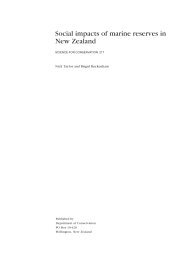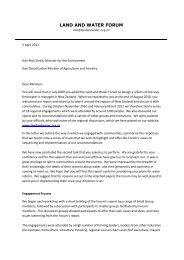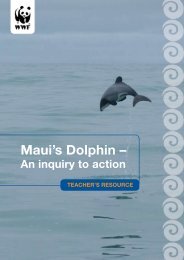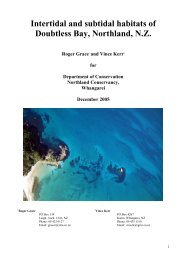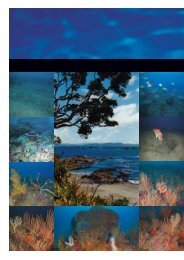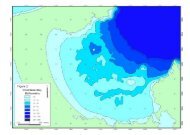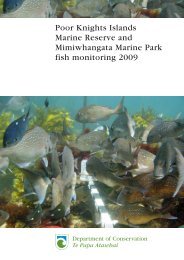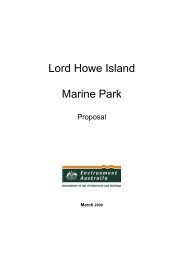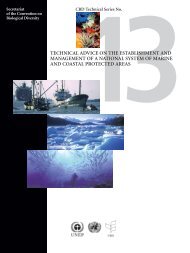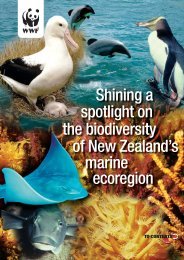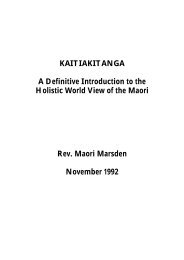Habitats and Ecological Values of the Hokianga ... - MarineNZ.org.nz
Habitats and Ecological Values of the Hokianga ... - MarineNZ.org.nz
Habitats and Ecological Values of the Hokianga ... - MarineNZ.org.nz
Create successful ePaper yourself
Turn your PDF publications into a flip-book with our unique Google optimized e-Paper software.
R.J. DAVIDSON: V. KERR<br />
HABITATS AND ECOLOGICAL VALUES OF HOKIANGA HARBOUR<br />
• Spartina<br />
• disturbance or loss <strong>of</strong> estuarine <strong>and</strong> freshwater habitats<br />
• introduction <strong>of</strong> contaminants<br />
• restoration or protection <strong>of</strong> peripheral habitats<br />
• protection <strong>of</strong> marginal vegetation from stock<br />
• creation <strong>of</strong> high tide bird roosts<br />
• predator <strong>and</strong> possum control around wetl<strong>and</strong> margins<br />
• promotion <strong>of</strong> estuary education, tourism <strong>and</strong> l<strong>and</strong>scape values<br />
• legal protection <strong>of</strong> fur<strong>the</strong>r areas<br />
6.0 Protection mechanisms <strong>and</strong> recommendations<br />
• Legislation options for <strong>the</strong> intertidal <strong>and</strong> subtidal environment<br />
• Concepts for <strong>the</strong> protection <strong>of</strong> <strong>the</strong> ecological values <strong>of</strong> <strong>Hokianga</strong> Harbour<br />
1.0 Existing <strong>Ecological</strong> Information<br />
1.1 <strong>Hokianga</strong> Harbour<br />
A variety <strong>of</strong> reports have been produced that outline values <strong>and</strong> threat in <strong>Hokianga</strong> Harbour. They<br />
are in brief summary:<br />
1) Davis <strong>and</strong> Bellingham (1984) stated that <strong>Hokianga</strong> Harbour was some 15,414 ha in size<br />
making it <strong>the</strong> fourth largest harbour in New Zeal<strong>and</strong>. The Harbour is a drowned river<br />
valley draining a catchment <strong>of</strong> 156,302 ha. Main rivers entering <strong>the</strong> Harbour are <strong>the</strong><br />
Manganuka, Waipapa-Waihau <strong>and</strong> <strong>the</strong> Waima-Taheke. Smaller rivers include <strong>the</strong><br />
Tapuwae, Whakarapa, Omania, Orira <strong>and</strong> <strong>the</strong> Whirinaki. There are numerous small streams<br />
<strong>and</strong> creeks that enter <strong>the</strong> Harbour. The authors listed <strong>and</strong> discussed <strong>the</strong> range <strong>of</strong> bird<br />
species <strong>and</strong> <strong>the</strong> areas that <strong>the</strong>y utilised in <strong>the</strong> Harbour. The authors also attached a habitat<br />
map outlining <strong>the</strong> major vegetation <strong>and</strong> substratum types.<br />
2) McLay (1976) stated that <strong>the</strong> tidal flow was <strong>the</strong> factor that predominantly influenced water<br />
circulation in <strong>the</strong> Harbour <strong>and</strong> not freshwater inflows.<br />
3) The authors <strong>of</strong> <strong>the</strong> Coastal Wetl<strong>and</strong> Inventory (Volume 2) stated that <strong>the</strong> Harbour was<br />
11,500 ha in size with approximately 2,900 ha supporting mangroves. The authors stated<br />
that during <strong>the</strong> 1930’s as depression relief work large areas <strong>of</strong> <strong>the</strong> Harbour was reclaimed.<br />
In addition, between 1979 <strong>and</strong> 1984, large areas <strong>of</strong> <strong>the</strong> Harbour were illegally reclaimed.<br />
4) In a Ministry <strong>of</strong> Agriculture <strong>and</strong> Fisheries publication investigating marine reserve options<br />
in <strong>the</strong> Auckl<strong>and</strong> region <strong>the</strong> authors stated that <strong>the</strong> upper <strong>Hokianga</strong> Harbour supported some<br />
<strong>of</strong> <strong>the</strong> finest large mangroves in New Zeal<strong>and</strong>.<br />
5) Ogle (1992) stated in a report on <strong>the</strong> wildlife values <strong>of</strong> Northl<strong>and</strong> that Spartina was<br />
abundant on particular mud-flat areas in <strong>the</strong> Harbour.<br />
6) In <strong>the</strong> <strong>Hokianga</strong> Harbour Plan Preliminary Draft (<strong>Hokianga</strong> County Council, 1985) <strong>the</strong><br />
authors stated that <strong>the</strong>re were two water quality problems in <strong>the</strong> Harbour (1) excessive<br />
siltation <strong>and</strong> water discolouration from accelerated erosion <strong>and</strong> (2) bacterial <strong>and</strong> viral<br />
pollution as a result <strong>of</strong> poor sewage disposal practices <strong>and</strong> surface run<strong>of</strong>f from pastural l<strong>and</strong>.<br />
These authors stated that changes to sewage reticulation schemes should improve <strong>the</strong><br />
PAGE 4 3/06/2005 DAVIDSON ENVIRONMENTAL LTD 389/2001





